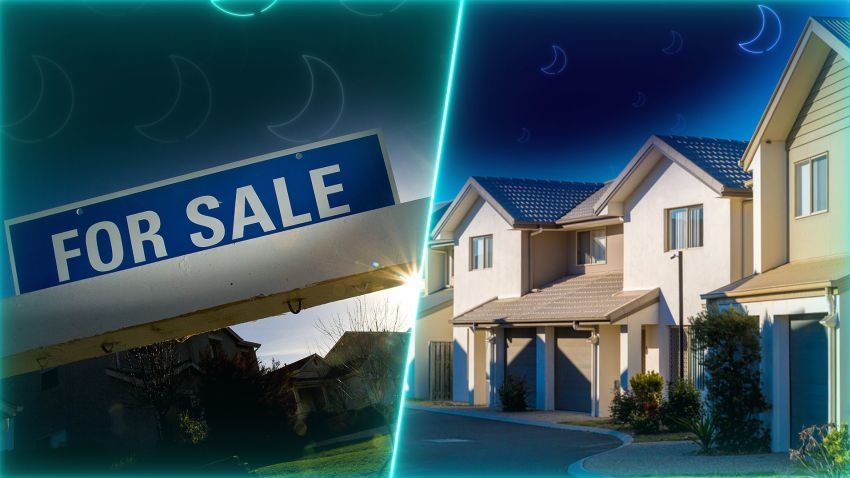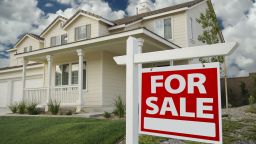So far this year, the real estate market has not been going the way many prospective homebuyers had hoped. Home prices – already at all-time highs – have continued to climb and mortgage rates have risen much faster than expected.
While some buyers have forged ahead, others have put their home search on hold or have given up entirely because the rising costs have put ownership out of reach.
But as recession fears for the larger economy loom, the housing market is showing signs of slowing. Sales of new construction homes are down and construction is stalling. Sales of existing homes have dropped and are trending below 2019 levels. As mortgage rates remain above 5%, applications have fallen to their lowest level in 22 years.
Still, neither home prices nor mortgage rates are expected to plummet and affording a home is likely to remain a challenge for the rest of the year, economists say. Home price gains are slowing, but year-over-year prices are still seeing double-digit increases. And the Federal Reserve announced another rate hike this week, which will keep mortgage rates volatile.
“Affordability is the biggest issue in the housing market today, and higher rates will make that worse on a monthly basis” said Skylar Olsen, chief economist at Zillow.
Mortgage rates will stabilize
The big surprise for those looking to buy a home during the first half of the year was how mortgage rates shot up so much, so fast. Interest rates for a 30-year, fixed-rate mortgage rose from 3.22% at the beginning of January to a high, so far this year, of 5.81% in June, according to Freddie Mac. In recent weeks, average rates have settled in around 5.5%.
“Someone buying the same house today that they wanted to buy last year will see a 50% increase in their monthly payment,” said Lawrence Yun, chief economist for the National Association of Realtors. “People’s incomes do not rise by 50% in a year. Homebuyers are frustrated. This year, they are in total disbelief that they don’t have the money to buy at a 6% mortgage rate.”
The cost of financing a home is so great that nearly 15% of people who signed a contract to buy a home in June backed out, according to Redfin. That’s the highest share of canceled home sales since April 2020, when the market all but stopped due to the pandemic.
But Yun said that while mortgage rates may tick up or down in the months to come, the biggest jumps have already happened.
“We may be topping out on mortgage rates,” he said.
Yun noted that mortgage rates may have largely already “priced-in” the Fed’s current and anticipated future interest rate hikes. He expects mortgage rates will settle in near 6% by year’s end and that home sales will normalize once mortgage rates become more stable.
Inventory will rise from last year
As the market slows, potential buyers who continue to search for a home will have less competition and more homes to chose from, offering more breathing room than the frenzied market of the past two years.
Economists were largely on target with their home price projections for the first half of the year – with annual price growth peaking in the spring and moderating as the year has gone on. But the number of sales at this point in the year is way below expectations, said Jeff Tucker, an economist at Zillow.
“Sales volume has taken a much bigger hit than prices,” he said. “Buyers soldiered through those mortgage rate increases longer than we thought – that kept prices high. But some buyers began to drop out.”
Yun said he anticipates 2022 sales will be down by about 13% from last year.
The upshot, said Tucker, is that as sales volumes continue to fall, inventory will tick up.
Soaring demand to buy a home during the past two years led to record low inventory of homes to buy and that pushed prices up. In June, inventory saw its first year-over-year turnaround in three years. The number of homes available for sale at the end of June was up 9.6% from May and 2.4% from a year ago, according to NAR.
Home prices will rise more slowly
The median price of a home reached a record high of $416,000 in June.
But the pace of price growth has been slowing lately. Median home prices for existing homes were up 13.4% in June from the year before, compared with the 23% spike in home prices in June 2021, according to NAR.
In addition, prices on new construction homes are actually falling. The median sales price of a new construction home dropped to $402,400 in June, down from $444,500 in May, according to the US Census Bureau and the Department of Housing and Urban Development.
“This is the biggest crack yet in home-price inflation,” said Robert Frick, corporate economist at Navy Federal Credit Union. “If existing home prices follow suit, we may finally see a break in annual increases that have priced millions of Americans out of the housing market.”
New construction homes make up roughly 10% of transactions and existing homes the other 90%. And prices for the vast majority of the market aren’t falling.
Yun said he expects home prices for this year will be up 11%. That’s less than the 16.9% year-over-year increase from 2020 to 2021, but more than he had predicted at the beginning of this year.
As higher mortgage rates tamp down buyer demand, inventory will rise and sales will fall, which should help prices to moderate the rest of this year.
“Homes may be sitting on the market longer, there will be more properties with price reductions,” Yun said. “Buyers who do deeper homework may be able to find a home with a price reduction or get a better price negotiation.”
Affordability will remain a challenge
Home affordability is the worst it’s been since 1989, with the exception of the housing bubble from 2004-2008, wrote David M. Dworkin and Bill McBride in a report for the National Housing Conference.
But during the housing bubble, the lack of affordability was driven by mortgages offering teaser interest rates of as low as 1% that reset to a level homeowners could not reliably pay. And in the 1980’s, homes were not affordable because of incredibly high interest rates – with 30-year fixed-rate mortgage rates spanning 9% to over 18%.
Today’s market is different, the researchers wrote. “Soaring housing costs are driven by the compounding impact of apparent underproduction between 2008 and 2020, housing supply chain failures since 2020, and increased demand since 2020.”
And that’s not likely to change much by the end of the year.
New home building has stalled as builders wait to see how well the current supply of homes sells before launching more construction.
Sam Khater, Freddie Mac’s chief economist, said he anticipates homebuyer demand to continue to cool to a more normal pace of activity – but that the ability for many people to buy a home will remain hard.
“The Federal Reserve’s action to help manage inflation has created significant volatility in mortgage rates and, by extension, the housing market,” said Khater. “Although house price appreciation will grow at a more moderate rate, home prices remain high relative to homebuyer incomes. Taken together, these factors are exacerbating affordability challenges and causing a slowdown in the housing market.”























